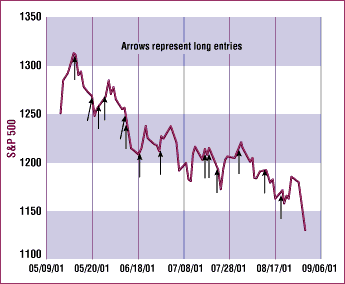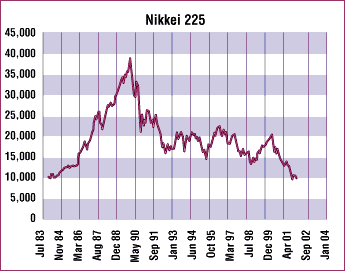
HOT TOPICS LIST
- Strategies
- Stocks
- Buy
- Investing
- Brokers
- Psychology
- Interviews
- Accumulate
- Sell
- Hold
- Spotlight
- Websites
- Candlestick Corner
- Gold & Metals
- Options Trading
LIST OF TOPICS
TRADER'S NOTEBOOK
What's Your Bias?
02/04/03 02:51:58 PM PSTby Paul Kluskowski
Bias is a common hurdle facing all beginning traders. How will you conquer it?
| When I was a beginning trader, a number of biases caused me to violate the golden rule of trading: Cut your losers short and let your winners run. This was partly because I had a need to be right about my stock selections. I was also unwilling to sell at a small loss. Finally, I tended to take losses personally, rather than accept them as a natural part of the process. After a series of nasty losses, I decided I had to do things differently; I had to get serious about learning how the most successful pros behave. And that started with the golden rule of trading. It wasn't until I became disciplined in applying the golden rule that my trading began to improve. This simple concept of cutting losses and letting winners run made success possible, but it was like peeling away the first layer of an onion — I had only begun to discover the biases that were costing me money.
GOING WITH THE FLOWIn swing trading, the odds of a trade going your way so that winners can run are dramatically improved by going with the market's flow. In other words, when the markets are trending up, your trading should favor long trades. When the markets are trending down, your trading should favor short trades. That seems pretty simple, yet when I conducted a periodic review of my trading activities (I keep detailed records of my entries and exits for review and improvement purposes), I found that my trades were always clearly skewed toward long entries, even when the market was trending down. In fact, over a period of several months, I found that long entries accounted for more than 90% of all my trades! Of course, taken by itself, this information gives little insight, so I superimposed the data on a chart of the Standard & Poor's 500 for the corresponding time period (see Figure 1). Examining the result, I realized I had taken a number of small losses with no big winners to offset them. And as you can probably guess, the market was in a downtrend. My personal bias had expressed itself in my trades, even though I was consciously aware of the need to go with the market's flow.
Figure 1: The S&P 500.
A NEW APPROACH
Considering this, I reached several conclusions. First, it was clear that I had not yet developed a means by which to assess market conditions. This caused me to enter the market in the opposite direction of the market's flow. As a result, I was consistently forced to cut my losers short. To remedy this, I now use a combination of J. Welles Wilder's directional movement indicators and William O'Neil's general market assessments. For those unfamiliar with these names, Welles Wilder's directional movement indicators provide a way to numerically determine whether a market index or an individual stock is trending or consolidating. In general, consolidating markets and stocks give choppy price action and can chew up capital quickly, so trending markets and stocks are usually preferred. More information can be found in a number of sources, including Wilder's book New Concepts In Technical Trading Systems. William O'Neil's market assessments involve close scrutiny of the general market's price and volume action. Up days on high volume are called accumulation days, while down days on high volume are distribution days. His methodology is described in his popular book How To Make Money In Stocks. O'Neil's methods tend to be less statistically challenging than Wilder's measures. My new strategies all came together successfully in a position in Kohl's (KSS) I entered on November 13, 2001, at 64.93. I held the position until June 2002, when I stopped out at a small profit. Had I done a better job managing my exit, it could have been a much larger profit. Unfortunately, I was still stuck in another of my unconscious biases: the idea that stocks go up over the long run more than they go down. My core belief was that the odds would favor those of us who are "net long" for the longest time frame. However, as many are painfully learning, some tremendous losses can result from this misguided belief. One look at the Nikkei (Figure 2), which has trended down for more than a decade, should serve to reinforce this point.
Figure 2: The Nikkei 225.
Having grown up as a conservative Midwesterner, my thinking patterns and comfort zone were entrenched in a kind of ownership mentality. As William Shakespeare said in Hamlet, "Neither a borrower nor a lender be" was my natural way of thinking; my unconscious bias was toward owning property free and clear. I gravitated toward net long strategies, and struggled with discomfort in net short situations, even when the markets trended down. I am now working to develop the psychological flexibility that statistical common sense dictates. Which brings me to my question: What's your bias? Where does it show up? Do you know your trading numbers? Does your strategy put you in the market's flow so that it works to your advantage, or are you trying to swim against the currents? And most important, do you know exactly how those unconscious biases will work against you? They can cost you money!
WHAT NEXT?If you find yourself, as I did, constantly fighting the market's flow, there are a few things you should do. First, stop what you are doing. Ask yourself, "What's happening here?" and once you know the answer, ask, "How can I correct it?" Finally, discipline yourself to be in a constant process of inquiry. When you encounter a trading bias, ask what it tells you about yourself. You are likely to be surprised — and enriched — by what you discover.
Paul Kluskowski lives in Washington, DC. He is the president of the local chapter of Van Tharp's International Institute of Trading Mastery. He can be contacted at dc@iitm.com.
SUGGESTED READINGO'Neil, William [1995]. How to Make Money In Stocks, McGraw-Hill.Tharp, Van [1999]. Trade Your Way To Financial Freedom, McGraw-Hill. Wilder, J. Welles [1978]. New Concepts In Technical Trading Systems, Trend Research. Value Line (datafeed)
Current and past articles from Working Money, The Investors' Magazine, can be found at Working-Money.com.
|
| E-mail address: | dc@iitm.com |
PRINT THIS ARTICLE

|

Request Information From Our Sponsors
- StockCharts.com, Inc.
- Candle Patterns
- Candlestick Charting Explained
- Intermarket Technical Analysis
- John Murphy on Chart Analysis
- John Murphy's Chart Pattern Recognition
- John Murphy's Market Message
- MurphyExplainsMarketAnalysis-Intermarket Analysis
- MurphyExplainsMarketAnalysis-Visual Analysis
- StockCharts.com
- Technical Analysis of the Financial Markets
- The Visual Investor
- VectorVest, Inc.
- Executive Premier Workshop
- One-Day Options Course
- OptionsPro
- Retirement Income Workshop
- Sure-Fire Trading Systems (VectorVest, Inc.)
- Trading as a Business Workshop
- VectorVest 7 EOD
- VectorVest 7 RealTime/IntraDay
- VectorVest AutoTester
- VectorVest Educational Services
- VectorVest OnLine
- VectorVest Options Analyzer
- VectorVest ProGraphics v6.0
- VectorVest ProTrader 7
- VectorVest RealTime Derby Tool
- VectorVest Simulator
- VectorVest Variator
- VectorVest Watchdog


